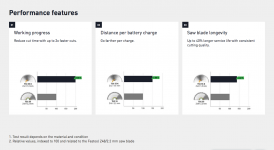Have used my cordless Metabo circular saw with the festool rail in the past to cut plywood and the results were abysmal. To say the least.
Blade flexing all over the place.
Guy on site all week with a Dewalt cordless track saw cutting plywood and most sheets were left with curve in the cut.
Fortuanetly my corded TS55 was on hand which left a perfect cut.
He was baffled as to how his saw was making bad cuts. I even adjusted the rollers to take up the slack on the rail for him.
Didn't make the slightest bit of difference.
Then it dawned on me only today what the real problem is.
Is their any point to cordless track saws with these super thin blades when they perform so badly?
Perhaps Mafell has cracked this issue?
How are Festool cordless track saws performing I wonder?
Blade flexing all over the place.
Guy on site all week with a Dewalt cordless track saw cutting plywood and most sheets were left with curve in the cut.
Fortuanetly my corded TS55 was on hand which left a perfect cut.
He was baffled as to how his saw was making bad cuts. I even adjusted the rollers to take up the slack on the rail for him.
Didn't make the slightest bit of difference.
Then it dawned on me only today what the real problem is.
Is their any point to cordless track saws with these super thin blades when they perform so badly?
Perhaps Mafell has cracked this issue?
How are Festool cordless track saws performing I wonder?

